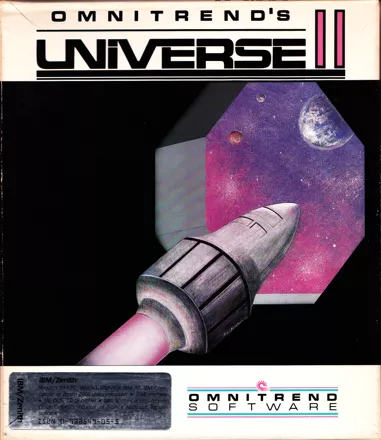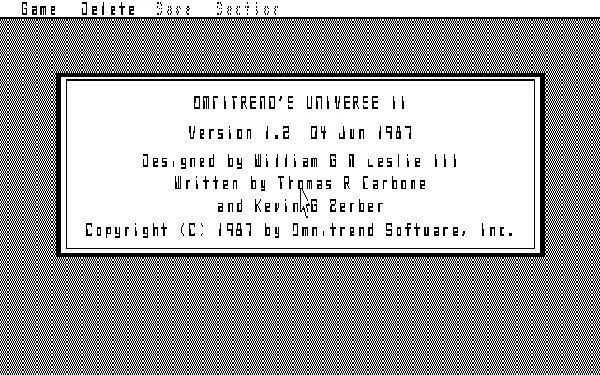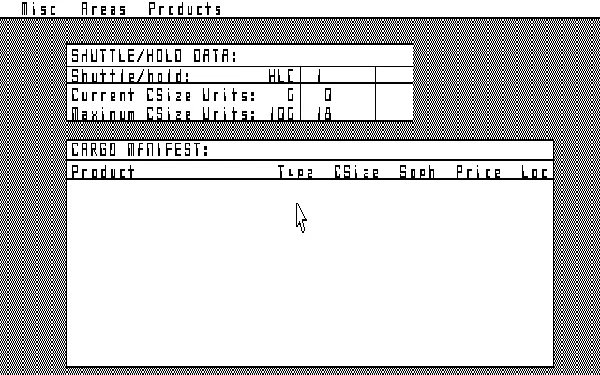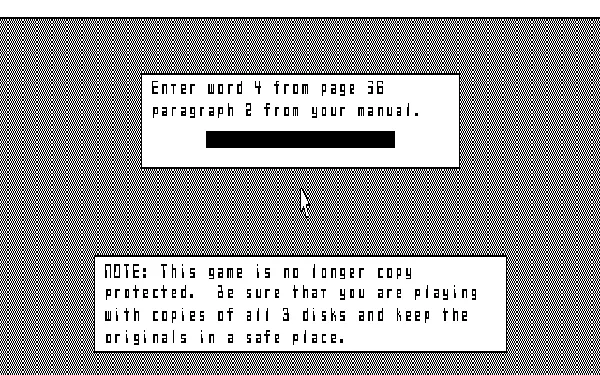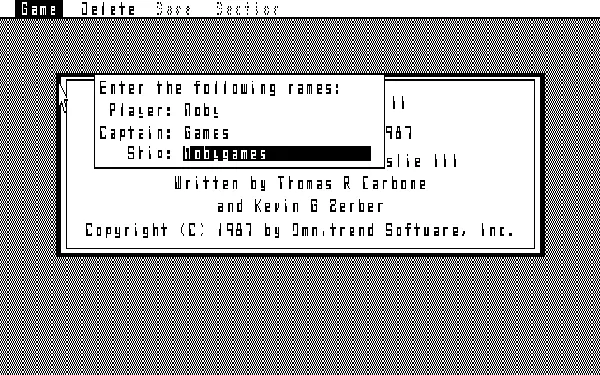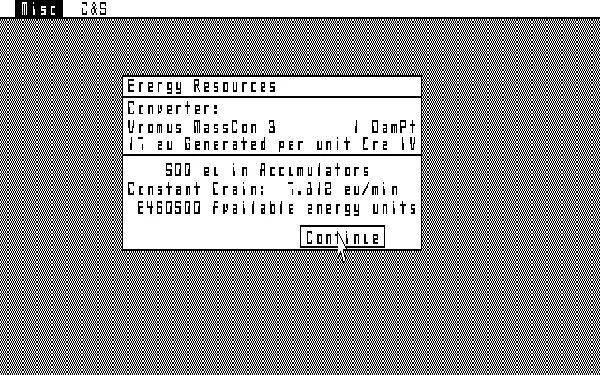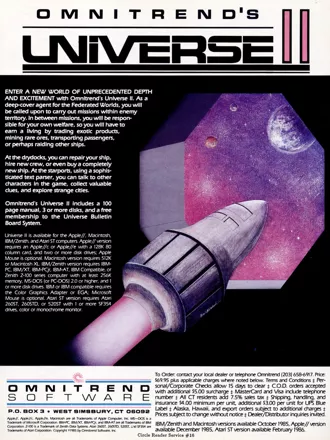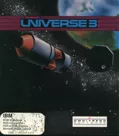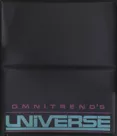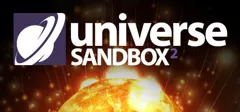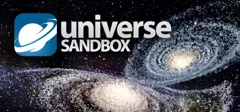Universe II
- Universe II (1979 on Apple II)
Description
Universe II is the sequel to Omnitrend's highly complex space simulation Universe. It takes place 20 years after the original game. A second hyperspace booster has been found, so there is hope that communication with Earth will be re-established in the foreseeable future. Still, the situation in the Local Group is tense. Two rival governments have formed: The Federated Worlds and the United Democratic Planets. Currently, travel and trade between the two is ongoing, but everyone fears the tensions will lead to all-out war.
The player takes the role of an undercover operative for the Federated Worlds. Disguised as a free trader from Vromus Prime, they will have to earn a living for themselves, because the FW only gives out money or equipment for special missions.
As in the original game, there are many ways of spending one's time and earning credits in the Local Cluster. Trade, exploration, passenger or freight transport, mining, smuggling, bounty hunting or piracy are among the many options.
Several different ships are available for purchase, each suited to different tasks. Some may have more room for mining equipment or cargo, others for weapons systems. Ships are highly customizable, with dozens of different models available for the likes of FTL and sub-light drives, energy converters, bridge and crew modules, computers, medical and communications systems, life support, scanners and more. Each part varies in damage it can take, size required for installing, visibility factor (highly visible parts are more likely to be hit in an attack) and sophistication (highly sophisticated parts can only be serviced and repaired in special drydocks).
A ship also requires a crew, and this is one area where Universe II differs from its predecessor: crew management is now much more complex, and comparable to a role-playing game. Crew members have one of seven specialties: captain, astrogator, gunner, pilot, miner, marine and engineer. Specialists are required for most tasks - without a miner mining is impossible, marines are required for man-to-man combat, only engineers can repair the ship's systems, et cetera. Crew members gain experience automatically with time, but can also be trained at a technical school in exchange for the right number of credits. They must also be fed, paid and require sleep. Their salary increases with experience. If there is no pay day for a while, they leave, whereas a lack of provisions naturally leads to starvation. The sleep requirements are simulated by assigning crew members to a watch cycle. A process called asomnigenation can eliminate the need for sleep in astrogators and gunners.
Another difference from the original game is a more detailed simulation of combat: when boarding an enemy ship, the player's marines must now capture the bridge by either killing all enemy marines or capturing 30% of the control panels. When deploying assault capsules to mine from an unwilling planet, any defense stations must be destroyed first. These combat engagements take place on special tactical screens.
Another new feature comes into play when docking at a starport: these sections are played in the manner of text adventures, utilizing a text parser. The bases can be freely explored, characters can be talked to, and valuable items and clues be found.
Universe II does away with the text-based interface of the original game, and (other for the text adventure parts) uses a menu-based window system not unlike the contemporary GEM or Macintosh interfaces.
Groups +
Screenshots
Promos
Credits (DOS version)
| Designed by | |
| Written by |
Reviews
Critics
Average score: 64% (based on 3 ratings)
| Critic [ Expand All ] | Platform | Score |
|---|---|---|
| Tilt | Apple II | 80% |
| ASM (Aktueller Software Markt) | Atari ST | 63% |
| Computer Gaming World (CGW) | DOS | 50% |
Players
Average score: 4.7 out of 5 (based on 6 ratings with 1 reviews)
A deep, well-balanced hybrid space adventure/simulation/rpg
The Good
The game world is well-realized, with an involving story of a cluster of Earth colonies divided into two factions struggling for control of a critical resource. As an intelligence agent playing the undercover role of a free trader, you have to make a living through mining, piracy or trade long enough and well enough to prepare yourself to take on missions and opportunities that arise as the interstellar conflict progresses and escalates. Many things throughout the game are well thought out by the designers and much of the game world just makes sense.
The economy of the game is extremely well-balanced. Your ship and crew are a constant drain on your resources and making a living is difficult, but achievable. Small successes open the door to upgrades which make meaningful improvements in the overall efficiency of your operation, without tipping the balance too far. The manual is extensive, thorough and well-written. Studying the manual to understand the interactions of ship systems is critical to exploiting opportunities.
There is considerable freedom in how you approach the game. You can genuinely have economic success by specializing in any of the opportunities available, so long as you plan appropriately. Success in any of trading, piracy or mining requires having appropriate crew, investing in the right ship systems and planning/scouting to take advantage of the right opportunities. Some of this requires note-taking and experimentation to succeed.
The game starts you off with a fully functional ship, a full fuel tank and enough credits to make some judicious investments, but not enough to optimize anything. Getting to peak efficiency is a slow but rewarding grind.
The various game sections (navigation, ship-to-ship combat, close-quarters combat, mining, trading, adventure) are all fully realized and function well (comments on the interface below).
The pace of the game is good. Every action takes time and the game events are scripted out over multiple years of in-game time. This gives you time to earn credits, develop your ship and crew, experiment with different activities without undue pressure to constantly be responding to requests from headquarters. When those requests come, you need to respond in a timely way and regularly checking for messages is necessary. There is plenty of warning in advance of the climax and enough hints on how to prepare, though even the ending gives you more than one way to succeed.
The missions that the game sprinkles in are well-varied and include a text parser espionage mission, some sight-seeing expeditions, a mission to hunt down a certain starship and forcibly extract intelligence, a text parser wilderness adventure with some puzzles and a maze, some random starport NPC interactions and a final confrontation with multiple possible outcomes. News events are also broadcasted to you throughout the game period, at least one of which provides a significant economic opportunity that can be exploited for profit. A couple of the intelligence missions have significant rewards that are beyond anything you can purchase in the game if you are successful.
The game makes it easy to save regularly and allows multiple save-games, so it is easy to experiment and backtrack if you want to. Insta-death is a possibility whenever you take an orbital shuttle to a planet, at certain times during text adventure segments and if you are targeted by a pirate while otherwise minding your own business.
The Bad
The main knock on the game would have to be the interface. Most of the game is operated through a menu interface which you can operate with either a mouse or context-sensitive hotkeys. Once you learn it, you can complete tasks fairly efficiently, but the hotkeys can sometimes be counterintuitive. In some cases, "X" will "exit" you out of a screen while in other cases, "D" will indicate you are "done". In one case "D" will also "dump cargo" in a context where you might think "done" will get you back to the previous screen.
Parts of the game play out in an Infocom-style text parser. I found these sections a bit frustrating for two reasons. First, the vast majority of time, you are simply navigating starports to reach a transaction terminal to load/unload passengers or sell ore/goods. This requires leaving your shuttle, travelling to the starport itself, passing through customs, navigating to the transaction room and then activating a terminal where you again enter into a menu-driven commerce interface. When you are done your business, it's back to the parser to exit the terminal, walk back to the transport platform, transfer to your shuttle, enter and ask your pilot to liftoff. Most of the starports have no other features besides the landing area, customs and a transaction room.
However, those starports that do have other features require working through the text parser to try to achieve some other objective, some of which will only open up once certain conditions are met. A couple of these text adventures were quite frustrating when it was difficult to come up with the expected syntax and one misstep could literally mean death. There were others where I was unable to make any meaningful headway, though it is possible certain locations were added just to provide a little colour to the world and there may not have been anything more to achieve.
There is an underlying element of randomness to much of the game world that isn't apparent until you have spent a lot of time in the game and have documented certain outcomes. For example, running a resource scan on a planet can have wildly different outcomes, but you can only run one scan each time you enter a planet's orbit. Attempting to scan again just gives an error message and you would need to transit to another planet or star and then return in order to run another scan. To find an optimal mining site therefore requires saving your game, running a scan, aborting your game and restoring, then scanning again. Each planet will have a range of possible densities for each of the 4 ore types in the game, but it would be extremely costly to determine this range without abusing saves. Similarly, each planet makes approximately 20-25 trade-goods and prices fly by on a ticker. With careful observation, you can determine an average price for each good and identify when a "good deal" pops up. Taking that item to a suitable planet SHOULD result in a profit, but there seems to be a random inflation/deflation factor that takes effect both when entering the buying window on planet A and the selling window in planet B. If you aren't aware that you're in an inflated environment when buying on planet A, you may be unable to turn a profit even with very thoughtful buying. If the selling prices are depressed when you reach planet B, you are likewise in trouble. Again, you can overcome this by saving your game before heading down to the planet and reloading if prices are depressed (or just taking your shuttle back to your ship and then descending again, but that would require running through the repetitive text parser steps again). On one hand, these random factors simulate reality a bit better and force you to manage risk through research, but it takes a lot of in-game time and research to even know these variable outcomes are possible.
Playing this on an emulator would be brutal due to the number of disk-swaps required. I played this on an Apple IIe in the 80's and it was a real slog. Getting through the entire game would have been almost inconceivable at the rate that things ran. Now that it has been released on GOG, it is smooth, seamless and fast.
The Bottom Line
This is an ambitious, deep and well-balanced game. For me, it was fun and involving to come back to this game decades after originally playing it and being stumped. Even that frustrating childhood experience of almost 40 years ago stayed with me though and I was excited to try this again. Nearing the end of my second full playthrough, it has been a real pleasure.
Be the first to rate this review!
Did you find this review helpful?
DOS · by deelow75 · 2025
Analytics
Identifiers +
Contribute
Are you familiar with this game? Help document and preserve this entry in video game history! If your contribution is approved, you will earn points and be credited as a contributor.
Contributors to this Entry
Game added by Terok Nor.
Windows added by Plok.
Additional contributors: Plok.
Game added October 24, 2011. Last modified August 2, 2024.


